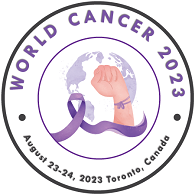
Rayjean J. Hung
Title: A risk prediction model for head and neck cancers incorporating lifestyle factors, HPV serology and genetic markers
Biography
Biography: Rayjean J. Hung
Abstract
Head and neck cancer is often diagnosed late and prognosis for most head and neck cancer patients remains poor. To aid early detection, we developed a risk prediction model based on demographic and lifestyle risk factors, human papillomavirus (HPV) serological markers and genetic markers. A total of 10 126 head and neck cancer cases and 5254 controls from five North American and European studies were included. HPV serostatus was determined by antibodies for HPV16 early oncoproteins (E6, E7) and regulatory early proteins (E1, E2, E4). The data were split into a training set (70%) for model development and a hold-out testing set (30%) for model performance evaluation, including discriminative ability and calibration. The risk models including demographic, lifestyle risk factors and polygenic risk score showed a reasonable predictive accuracy for head and neck cancer overall. A risk model that also included HPV serology showed substantially improved predictive accuracy for oropharyngeal cancer (AUC = 0.94, 95% CI = 0.92-0.95 in men and AUC = 0.92, 95% CI = 0.88-0.95 in women). The 5-year absolute risk estimates showed distinct trajectories by risk factor profiles. Based on the UK Biobank cohort, the risks of developing oropharyngeal cancer among 60 years old and HPV16 seropositive in the next 5 years ranged from 5.8% to 14.9% with an average of 8.1% for men, 1.3% to 4.4% with an average of 2.2% for women. Absolute risk was generally higher among individuals with heavy smoking, heavy drinking, HPV seropositivity and those with higher polygenic risk score. These risk models may be helpful for identifying people at high risk of developing head and neck cancer.

